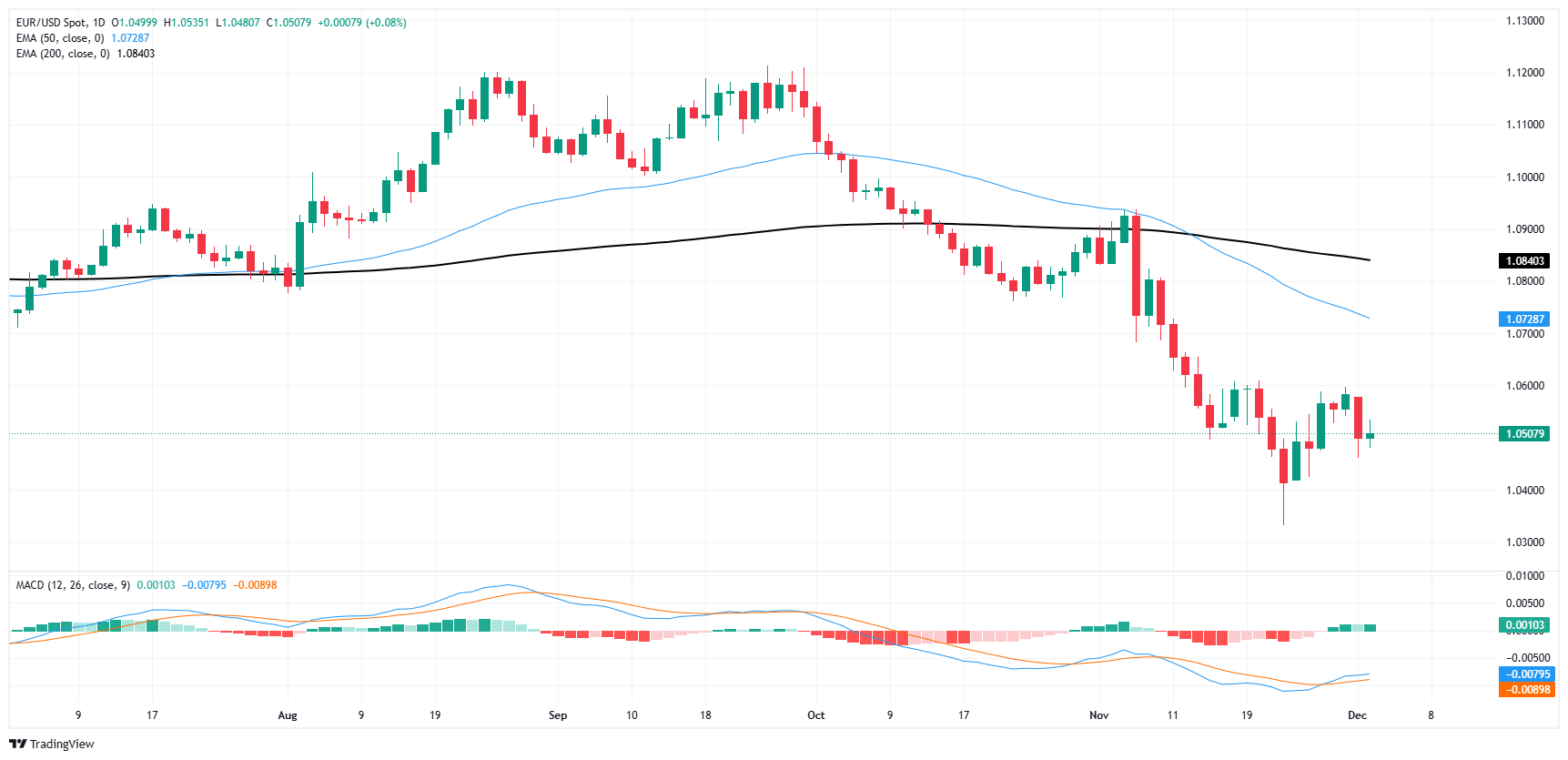EUR/USD trapped below 1.06
- EUR/USD softened on Tuesday, ending a bullish recovery attempt.
- Final EU PMIs, ECB Lagarde appearance unlikely to move the Fiber needle.
- US data focus shifts to Fed Chair Powell appearance, Friday NFP jobs print.
EUR/USD turned lower once again on Tuesday, grappling with the 1.0500 handle as Fiber flubs a bullish run at 1.0600. Several EU-centric datapoints are releasing on Wednesday, but most of the figures are final prints that are unlikely to move markets, and most investors are pivoting to face US Nonfarm Payrolls (NFP) jobs data due at the end of the week.
Pan-EU final Purchasing Managers Index (PMI) survey results for November will release early Wednesday, but the numbers are expected to stay the same. European Central Bank (ECB) President Christine Lagarde will also be making an appearance, and will testify before the Economic and Monetary Affairs Comittee before the European Parliament. Any market-moving announcements from the ECB are unlikely to materialize from the question period.
US ADP Non-Farm Employment Change numbers are due on Wednesday, and are expected to swing lower to 150K from the previous 233K. Wednesday will also bring the Services component for ISM US Purchasing Managers Index (PMI) dropping onto investors during the day’s American trading session. US Services PMI activity survey results are expected to tick down to 55.5 in November, down from the previous month’s 56.0.
Federal Reserve (Fed) Chair Jerome Powell is also expected to appear on Wednesday. The Fed head will answer audience questions during a moderated discussion hosted by the New York Times.
EUR/USD price forecast
EUR/USD is stuck in the dumps near 1.0500 after a bullish recovery fizzled. Fiber only managed to squeeze out a single green weekly candlestick after hitting multi-year lows near 1.0330. The 50-day and 200-day Exponential Moving Averages (EMA) have confirmed a bearish cross, with the 50-day EMA accelerating downward into 1.0700 as the 200-day EMA prices in a firm ceiling near 1.0840.
EUR/USD daily chart
Euro FAQs
The Euro is the currency for the 19 European Union countries that belong to the Eurozone. It is the second most heavily traded currency in the world behind the US Dollar. In 2022, it accounted for 31% of all foreign exchange transactions, with an average daily turnover of over $2.2 trillion a day. EUR/USD is the most heavily traded currency pair in the world, accounting for an estimated 30% off all transactions, followed by EUR/JPY (4%), EUR/GBP (3%) and EUR/AUD (2%).
The European Central Bank (ECB) in Frankfurt, Germany, is the reserve bank for the Eurozone. The ECB sets interest rates and manages monetary policy. The ECB’s primary mandate is to maintain price stability, which means either controlling inflation or stimulating growth. Its primary tool is the raising or lowering of interest rates. Relatively high interest rates – or the expectation of higher rates – will usually benefit the Euro and vice versa. The ECB Governing Council makes monetary policy decisions at meetings held eight times a year. Decisions are made by heads of the Eurozone national banks and six permanent members, including the President of the ECB, Christine Lagarde.
Eurozone inflation data, measured by the Harmonized Index of Consumer Prices (HICP), is an important econometric for the Euro. If inflation rises more than expected, especially if above the ECB’s 2% target, it obliges the ECB to raise interest rates to bring it back under control. Relatively high interest rates compared to its counterparts will usually benefit the Euro, as it makes the region more attractive as a place for global investors to park their money.
Data releases gauge the health of the economy and can impact on the Euro. Indicators such as GDP, Manufacturing and Services PMIs, employment, and consumer sentiment surveys can all influence the direction of the single currency. A strong economy is good for the Euro. Not only does it attract more foreign investment but it may encourage the ECB to put up interest rates, which will directly strengthen the Euro. Otherwise, if economic data is weak, the Euro is likely to fall. Economic data for the four largest economies in the euro area (Germany, France, Italy and Spain) are especially significant, as they account for 75% of the Eurozone’s economy.
Another significant data release for the Euro is the Trade Balance. This indicator measures the difference between what a country earns from its exports and what it spends on imports over a given period. If a country produces highly sought after exports then its currency will gain in value purely from the extra demand created from foreign buyers seeking to purchase these goods. Therefore, a positive net Trade Balance strengthens a currency and vice versa for a negative balance.